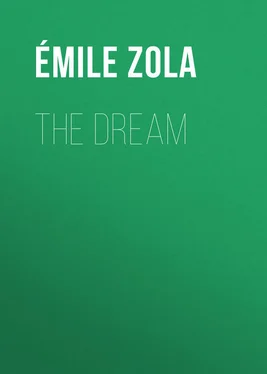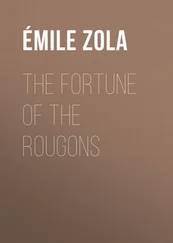Émile Zola - The Dream
Здесь есть возможность читать онлайн «Émile Zola - The Dream» — ознакомительный отрывок электронной книги совершенно бесплатно, а после прочтения отрывка купить полную версию. В некоторых случаях можно слушать аудио, скачать через торрент в формате fb2 и присутствует краткое содержание. Жанр: literature_19, foreign_antique, foreign_prose, на английском языке. Описание произведения, (предисловие) а так же отзывы посетителей доступны на портале библиотеки ЛибКат.
- Название:The Dream
- Автор:
- Жанр:
- Год:неизвестен
- ISBN:нет данных
- Рейтинг книги:3 / 5. Голосов: 1
-
Избранное:Добавить в избранное
- Отзывы:
-
Ваша оценка:
- 60
- 1
- 2
- 3
- 4
- 5
The Dream: краткое содержание, описание и аннотация
Предлагаем к чтению аннотацию, описание, краткое содержание или предисловие (зависит от того, что написал сам автор книги «The Dream»). Если вы не нашли необходимую информацию о книге — напишите в комментариях, мы постараемся отыскать её.
The Dream — читать онлайн ознакомительный отрывок
Ниже представлен текст книги, разбитый по страницам. Система сохранения места последней прочитанной страницы, позволяет с удобством читать онлайн бесплатно книгу «The Dream», без необходимости каждый раз заново искать на чём Вы остановились. Поставьте закладку, и сможете в любой момент перейти на страницу, на которой закончили чтение.
Интервал:
Закладка:
Émile Zola
The Dream
CHAPTER I
During the severe winter of 1860 the river Oise was frozen over and the plains of Lower Picardy were covered with deep snow. On Christmas Day, especially, a heavy squall from the north-east had almost buried the little city of Beaumont. The snow, which began to fall early in the morning, increased towards evening and accumulated during the night; in the upper town, in the Rue des Orfevres, at the end of which, as if enclosed therein, is the northern front of the cathedral transept, this was blown with great force by the wind against the portal of Saint Agnes, the old Romanesque portal, where traces of Early Gothic could be seen, contrasting its florid ornamentation with the bare simplicity of the transept gable.
The inhabitants still slept, wearied by the festive rejoicings of the previous day. The town-clock struck six. In the darkness, which was slightly lightened by the slow, persistent fall of flakes, a vague living form alone was visible: that of a little girl, nine years of age, who, having taken refuge under the archway of the portal, had passed the night there, shivering, and sheltering herself as well as possible. She wore a thin woollen dress, ragged from long use, her head was covered with a torn silk handkerchief, and on her bare feet were heavy shoes much too large for her. Without doubt she had only gone there after having well wandered through the town, for she had fallen down from sheer exhaustion. For her it was the end of the world; there was no longer anything to interest her. It was the last surrender; the hunger that gnaws, the cold which kills; and in her weakness, stifled by the heavy weight at her heart, she ceased to struggle, and nothing was left to her but the instinctive movement of preservation, the desire of changing place, of sinking still deeper into these old stones, whenever a sudden gust made the snow whirl about her.
Hour after hour passed. For a long time, between the divisions of this double door, she leaned her back against the abutting pier, on whose column was a statue of Saint Agnes, the martyr of but thirteen years of age, a little girl like herself, who carried a branch of palm, and at whose feet was a lamb. And in the tympanum, above the lintel, the whole legend of the Virgin Child betrothed to Jesus could be seen in high relief, set forth with a charming simplicity of faith. Her hair, which grew long and covered her like a garment when the Governor, whose son she had refused to marry, gave her up to the soldiers; the flames of the funeral pile, destined to destroy her, turning aside and burning her executioners as soon as they lighted the wood; the miracles performed by her relics; Constance, daughter of the Emperor, cured of leprosy; and the quaint story of one of her painted images, which, when the priest Paulinus offered it a very valuable emerald ring, held out its finger, then withdrew it, keeping the ring, which can be seen at this present day. At the top of the tympanum, in a halo of glory, Agnes is at last received into heaven, where her betrothed, Jesus, marries her, so young and so little, giving her the kiss of eternal happiness.
But when the wind rushed through the street, the snow was blown in the child’s face, and the threshold was almost barred by the white masses; then she moved away to the side, against the virgins placed above the base of the arch. These are the companions of Agnes, the saints who served as her escort: three at her right – Dorothea, who was fed in prison by miraculous bread; Barbe, who lived in a tower; and Genevieve, whose heroism saved Paris: and three at her left – Agatha, whose breast was torn; Christina, who was put to torture by her father; and Cecilia, beloved by the angels. Above these were statues and statues; three close ranks mounting with the curves of the arches, decorating them with chaste triumphant figures, who, after the suffering and martyrdom of their earthly life, were welcomed by a host of winged cherubim, transported with ecstasy into the Celestial Kingdom.
There had been no shelter for the little waif for a long time, when at last the clock struck eight and daylight came. The snow, had she not trampled it down, would have come up to her shoulders. The old door behind her was covered with it, as if hung with ermine, and it looked as white as an altar, beneath the grey front of the church, so bare and smooth that not even a single flake had clung to it. The great saints, those of the sloping surface especially, were clothed in it, and were glistening in purity from their feet to their white beards. Still higher, in the scenes of the tympanum, the outlines of the little saints of the arches were designed most clearly on a dark background, and this magic sect continued until the final rapture at the marriage of Agnes, which the archangels appeared to be celebrating under a shower of white roses. Standing upon her pillar, with her white branch of palm and her white lamp, the Virgin Child had such purity in the lines of her body of immaculate snow, that the motionless stiffness of cold seemed to congeal around her the mystic transports of victorious youth. And at her feet the other child, so miserable, white with snow – she also grew so stiff and pale that it seemed as if she were turning to stone, and could scarcely be distinguished from the great images above her.
At last, in one of the long line of houses in which all seemed to be sleeping, the noise from the drawing up of a blind made her raise her eyes. It was at her right hand, in the second story of a house at the side of the Cathedral. A very handsome woman, a brunette about forty years of age, with a placid expression of serenity, was just looking out from there, and in spite of the terrible frost she kept her uncovered arm in the air for a moment, having seen the child move. Her calm face grew sad with pity and astonishment. Then, shivering, she hastily closed the window. She carried with her the rapid vision of a fair little creature with violet-coloured eyes under a head-covering of an old silk handkerchief. The face was oval, the neck long and slender as a lily, and the shoulders drooping; but she was blue from cold, her little hands and feet were half dead, and the only thing about her that still showed life was the slight vapour of her breath.
The child remained with her eyes upturned, looking at the house mechanically. It was a narrow one, two stories in height, very old, and evidently built towards the end of the fifteenth century. It was almost sealed to the side of the Cathedral, between two buttresses, like a wart which had pushed itself between the two toes of a Colossus. And thus supported on each side, it was admirably preserved, with its stone basement, its second story in wooden panels, ornamented with bricks, its roof, of which the framework advanced at least three feet beyond the gable, its turret for the projecting stairway at the left corner, where could still be seen in the little window the leaden setting of long ago. At times repairs had been made on account of its age. The tile-roofing dated from the reign of Louis XIV, for one easily recognised the work of that epoch; a dormer window pierced in the side of the turret, little wooden frames replacing everywhere those of the primitive panes; the three united openings of the second story had been reduced to two, that of the middle being closed up with bricks, thus giving to the front the symmetry of the other buildings on the street of a more recent date.
In the basement the changes were equally visible, an oaken door with mouldings having taken the place of the old one with iron trimmings that was under the stairway; and the great central arcade, of which the lower part, the sides, and the point had been plastered over, so as to leave only one rectangular opening, was now a species of large window, instead of the triple-pointed one which formerly came out on to the street.
Читать дальшеИнтервал:
Закладка:
Похожие книги на «The Dream»
Представляем Вашему вниманию похожие книги на «The Dream» списком для выбора. Мы отобрали схожую по названию и смыслу литературу в надежде предоставить читателям больше вариантов отыскать новые, интересные, ещё непрочитанные произведения.
Обсуждение, отзывы о книге «The Dream» и просто собственные мнения читателей. Оставьте ваши комментарии, напишите, что Вы думаете о произведении, его смысле или главных героях. Укажите что конкретно понравилось, а что нет, и почему Вы так считаете.












